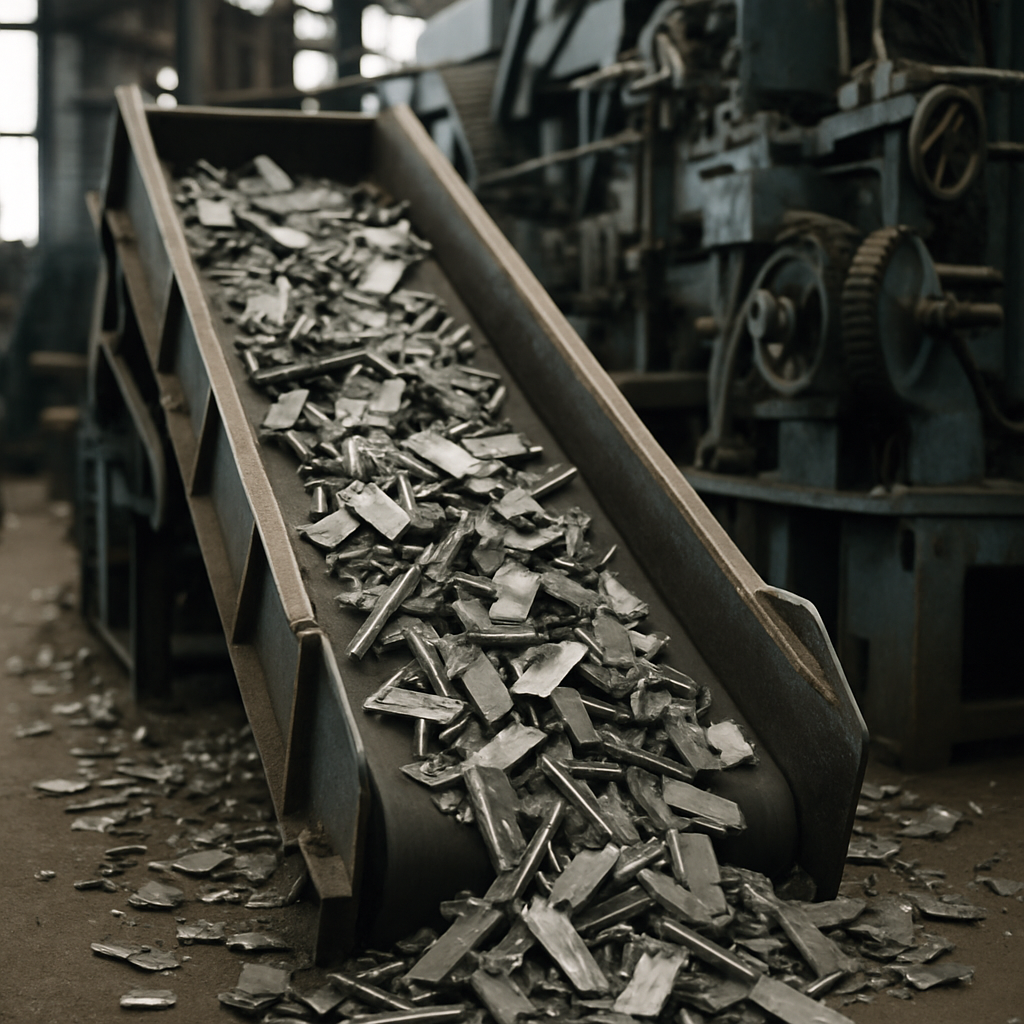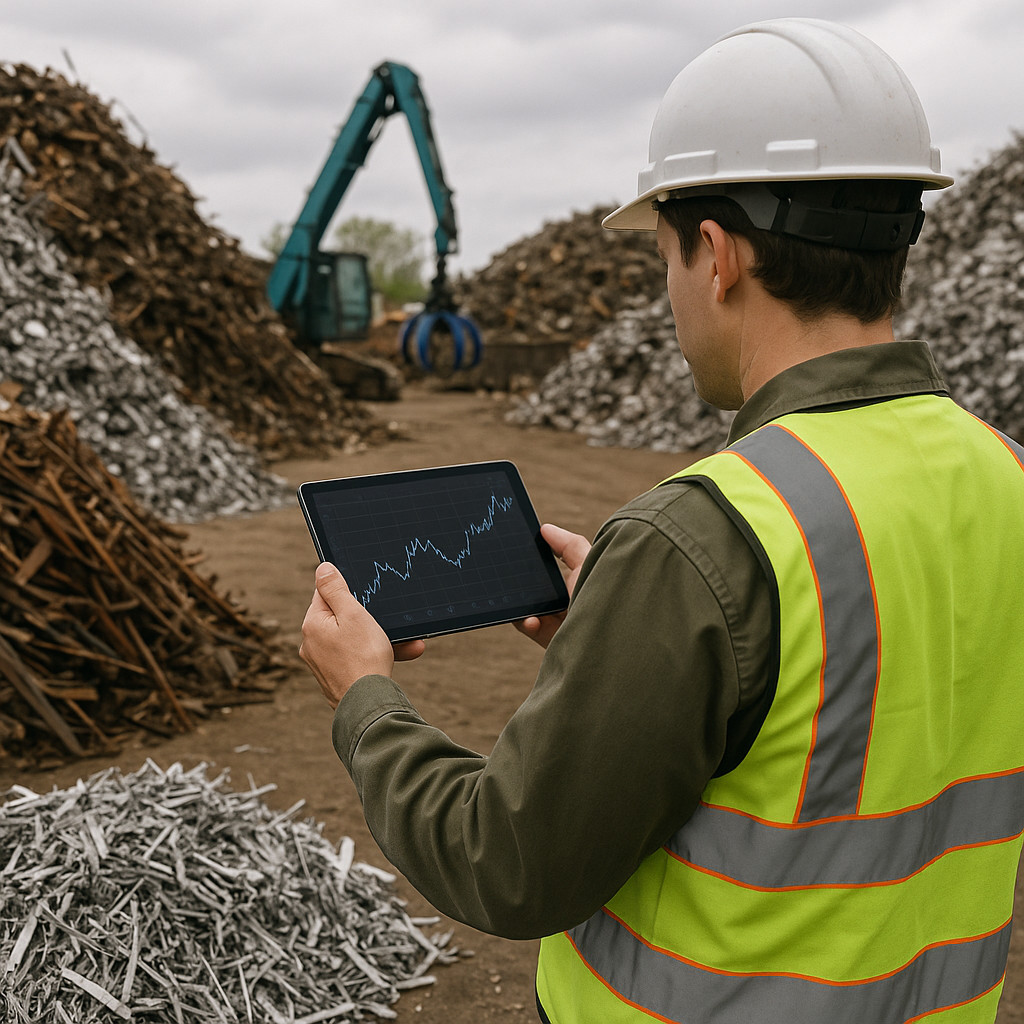5901 Botham Jean Blvd, Dallas, TX 75215
Current Waste Metal Prices: Copper, Aluminum, Steel & Brass Rates
September 19, 2025The ever-changing landscape of materials recovery sees scrap metal prices fluctuating due to market conditions, global demand, and economic factors. As of September 2025, ferrous metals like steel command approximately $100-165 per ton, with prepared steel reaching the higher end of that range. Cast iron and brake rotors are particularly valuable within this category.
Non-ferrous metals continue to maintain stronger per-pound values. Copper currently trades between $2.40-3.70 per pound, with bare bright copper wire at the premium end. Aluminum prices range from $0.55-0.82 per pound, with clean aluminum rims and 6063 bare aluminum bringing top dollar. Brass is valued between $1.25-2.20 per pound, with bronze slightly outperforming standard plumbing brass.
These prices represent a snapshot of current market conditions. Steel prices have remained relatively stable this month, while copper has seen modest increases of about $0.10 per pound since August. Aluminum values have shifted within a $0.25 per pound range during the same period. Both domestic and export markets influence these fluctuations, with tariffs and seasonal factors significantly affecting pricing.
How Do Different Metal Types Impact Pricing?

The type of metal you’re recycling significantly influences its value. The metals marketplace operates with distinct price tiers based on intrinsic value, rarity, and industrial demand. Copper and brass consistently rank as the most valuable common scrap metals, with prices significantly higher than other materials.
Copper
Copper commands premium pricing due to its exceptional conductivity and widespread use in electrical applications. Clean copper without contaminants can fetch up to 30-40 times more value than steel. The reddish-brown metal is highly sought after in construction, electronics, and renewable energy sectors, maintaining strong demand even during economic fluctuations.
Brass
Brass, an alloy containing copper and zinc, typically commands about half the price of pure copper but still offers excellent value. Its distinctive golden color makes it easily identifiable, and its applications in plumbing fixtures, musical instruments, and decorative items ensure steady market demand.
Aluminum
Aluminum follows in the value hierarchy, offering approximately one-fifth of copper’s price per pound. Despite its lower per-pound value, aluminum’s lightweight nature and abundance make it a recycling staple. The metal’s extensive use in transportation, packaging, and building materials creates reliable recycling streams from beverage cans to window frames.
Steel and Iron
Steel and iron, while commanding lower prices individually, dominate recycling volume due to their widespread use. These ferrous metals contain iron, making them magnetic and generally less valuable than non-ferrous alternatives. However, their abundance in everything from appliances to vehicles ensures consistent demand from mills and foundries worldwide.
At the specialty end of the spectrum, rare metals create niche but valuable recycling opportunities. Tungsten, valued at approximately $3.25 per pound, finds applications in high-density applications like counterweights and radiation shielding. Titanium, ranging from $0.35 to $1.00 per pound, serves critical roles in aerospace and medical applications.
| Metal | Price Range ($ per lb) |
|---|---|
| Copper (Bare Bright) | 3.40-4.00 |
| Copper Tubing / Pipe (#1) | 3.40-3.90 |
| Aluminum (Clean Extruded) | 0.60-0.80 |
| Aluminum (Rims) | 0.40-0.60 |
| Brass (Yellow) | 1.90-2.50 |
| Brass (Red) | 2.30-3.00 |
| Bronze | 2.30-2.80 |
| Stainless Steel (Non-Magnetic 304/316) | 0.30-0.45 |
Metal purity significantly impacts final pricing. Contaminated metals require additional processing, reducing their value. For example, copper wire with insulation intact will fetch less than stripped “bare bright” copper. Similarly, aluminum with attachments or coatings receives lower prices than clean material.
What Factors Influence Waste Metal Prices?

Waste metal prices fluctuate due to various economic forces and market conditions. Understanding these factors helps businesses and individuals to maximize the value of their recyclable metals. Global economic indicators, industrial activity, and regional variations are crucial in determining what recyclers will pay for scrap materials.
Global Economic Conditions
Economic growth influences waste metal demand and pricing directly. During periods of strong GDP growth, manufacturing and construction sectors expand, increasing demand for raw materials, including recycled metals. This relationship creates a predictable pattern that recyclers can monitor.
Conversely, economic downturns lead to reduced industrial output and lower metal prices. The 2008 financial crisis demonstrated this dramatically when scrap metal prices dropped by over 50% as manufacturing contracted globally. More recently, the COVID-19 pandemic caused US scrap steel prices to fall to approximately $190 per ton in April 2020, down from $300 just months earlier.
Currency fluctuations also significantly impact the global waste metal trade. Since scrap metal is priced in US dollars internationally, exchange rate movements affect exporters and importers differently. When a country’s currency strengthens against the dollar, its scrap exports become more expensive, potentially leading to reduced demand and lower domestic prices.
Industrial Demand and Supply Dynamics
The balance between global demand and supply is a fundamental driver of waste metal prices. Industries such as construction, automotive, and technology consume large quantities of recycled metals. When these sectors experience growth, demand increases, and prices typically rise.
China’s industrial activity has become particularly influential in global scrap markets. As the world’s largest steel producer, fluctuations in Chinese manufacturing output affect prices worldwide. When Chinese factories operate at high capacity, demand for imported scrap rises, driving global prices up.
Seasonal variations also impact the supply of scrap metals. Construction halts in winter in many regions lead to lower collection rates. Similarly, the agricultural sector’s off-season might limit machinery and equipment disposal. These seasonal patterns create predictable fluctuations in available supply and corresponding price adjustments.
Commodity Market Trends
The US Producer Price Index for ferrous metal scrap, currently at 464.62, offers valuable insight into market movements. This index tracks price changes received by domestic producers for their output and serves as a benchmark for the scrap industry. Monitoring this index helps recyclers and sellers anticipate price trends and time their transactions accordingly.
Market speculation and trading activities on commodity exchanges also influence scrap metal prices. Professional traders analyzing supply and demand projections can drive price movements through their buying and selling activities. These market dynamics create both challenges and opportunities for participants in the recycling industry.
| Factor | Description |
| Global Demand and Supply | The supply-demand balance dictates price changes. High demand and low supply increase prices, while the opposite reduces them. |
| Commodity Markets | Prices are linked to metal commodity trading, which fluctuates with market speculation and economic changes. |
| Energy Costs | Recycling is energy-intensive. High energy prices raise processing costs, impacting scrap prices. |
| Currency Exchange Rates | A strong domestic currency makes exports expensive, potentially reducing prices, whereas a weaker currency can boost exports and increase prices. |
| Regulations and Policies | Government regulations can influence prices. Stricter regulations can reduce virgin metal supply, increasing demand for recycled metals. |
Regional and Local Factors
Transportation costs significantly impact the prices recyclers can offer for waste metal. As fuel prices increase, the cost of moving scrap from collection points to processing facilities rises. Recyclers must factor these expenses into their pricing structures, often resulting in lower payouts in regions with high logistics costs.
Regional economic disparities create price differentials across different geographical areas. Developing economies with rapid infrastructure growth generate strong demand for recycled metals. Meanwhile, advanced economies with mature recycling systems may produce scrap surpluses. These variations create opportunities for trading across regions while adding complexity to price determinations.
Local competition among recyclers also influences prices offered to sellers. Areas with multiple competing facilities typically offer better rates than those with limited recycling options. This competitive landscape encourages recyclers to optimize their operations and pricing strategies to attract suppliers.
Regulatory Influences
Government policies regarding trade significantly shape the waste metal landscape. Tariffs, export restrictions, and import bans can dramatically alter supply chains and pricing structures. When the US imposed a 25% tariff on steel imports in 2018, it created ripple effects throughout the scrap market. Domestic steel production increased, raising demand for local scrap metal.
Environmental regulations impose compliance costs on recycling operations. Recyclers must invest in pollution control equipment, monitoring systems, and proper waste management. These regulatory requirements increase operational expenses, potentially affecting the prices recyclers can offer suppliers.
As sustainability becomes increasingly important, carbon pricing mechanisms may further shift the economics of metal recycling. Since recycled metals generally have a much lower carbon footprint than virgin materials, carbon taxes or cap-and-trade systems could create additional price advantages for scrap in the future.
How Can You Get the Best Prices for Your Waste Metal?

The scrap metal market depends on fluctuating prices affected by global supply and demand, economic conditions, and regional factors. Achieving the best value for your waste metal requires proactive planning and preparation. Implementing a few essential practices can significantly enhance your returns.
Separate and Clean Your Metals
Proper sorting is crucial for maximizing scrap value. Start by distinguishing between ferrous (magnetic) and non-ferrous (non-magnetic) metals using a simple magnet test. Non-ferrous metals like copper, aluminum, and brass usually fetch higher prices than ferrous metals like steel and iron.
Further sort your metals by specific type. Separate copper pipes from copper wiring, and aluminum cans from aluminum siding. This detailed sorting ensures you receive the correct price for each metal category.
Clean metals command higher prices than contaminated ones. Remove dirt, grease, paint, and rust before recycling. For valuable metals like copper, even a thin layer of corrosion can reduce its grade and price significantly. Use wire brushes for rust removal and appropriate cleaners for grease and dirt.
Shop Around for the Best Rates
Price comparison is vital in the scrap metal industry. Rates can vary by 10-30% between different scrap yards in the same area. Contact multiple recyclers to inquire about their current prices for specific metal types.
Consider creating a spreadsheet to track prices from different yards. Note any significant price discrepancies, especially for high-value metals. While small variations of 5-10 cents per pound for copper or aluminum are normal, larger differences merit attention.
Look for transparent pricing policies. Reputable recyclers will openly display their current rates on price boards, websites, or apps. Yards that withhold pricing information until after weighing your load may not offer the most competitive rates.
Timing Your Sales Strategically
Metal prices fluctuate based on market conditions. Monitoring these trends can help you time your sales for maximum profit. Various industry websites and apps track scrap metal prices, offering valuable insights into market movements.
Consider holding onto higher-value metals during price dips if storage space permits. Conversely, selling during price upswings can significantly boost your returns. For regular scrappers, developing a habit of checking weekly price trends can lead to more informed selling decisions.
Seasonal factors also influence scrap metal prices. Construction typically increases during spring and summer, often boosting demand for structural metals. Understanding these patterns allows you to anticipate potential price changes.
Build Relationships with Recyclers
Establishing ongoing relationships with scrap yards can lead to preferential treatment and better prices. Many recyclers offer loyalty programs or premium rates for regular customers. Consistent business relationships often result in more favorable grading of your materials.
For businesses generating regular scrap, negotiate standing agreements with recyclers. These arrangements can include locked-in minimum prices, scheduled pickups, and volume-based pricing structures that benefit both parties.
Communication matters too. Discuss your recycling goals with yard managers and ask about ways to increase the value of your materials. Their expertise can guide you toward more profitable recycling practices.
Consider Volume and Transportation
Bulk quantities generally command better prices. If possible, accumulate larger amounts of metal before selling. This approach reduces your transportation costs per pound and often qualifies you for volume-based pricing incentives.
For substantial quantities, inquire about commercial pickup services. Many recyclers offer free collection for qualifying amounts, saving you transportation costs and handling efforts. These services are particularly valuable for businesses generating regular scrap metal.
When transporting metals yourself, consolidate trips to maximize efficiency. Calculate whether the price difference between yards justifies additional transportation costs. Sometimes a slightly lower price at a closer location results in better overall returns when considering fuel and time expenses.
Conclusion: Navigating the Waste Metal Market

Navigating the waste metal market requires both knowledge and strategy. Throughout this article, we have explored how proper metal sorting, an understanding of market trends, and partnering with reputable recyclers are essential for maximizing returns. The market may fluctuate due to global economic conditions and industry demands, but the fundamental value of metal recycling remains constant. By implementing smart recycling practices—such as cleaning materials before recycling, selling in bulk, and staying informed about current prices—individuals and businesses can transform what was once considered waste into a valuable resource.
The metal recycling industry continues to evolve with technological advances in sorting and processing. As sustainability becomes increasingly important across all sectors, the demand for recycled metals is likely to grow.
Whether you are looking to recycle small amounts of household metal or manage industrial scrap from manufacturing processes, contact Okon Recycling at 214-717-4083 for your recycling needs. Our team can help you navigate the complexities of the waste metal market and ensure you receive competitive rates while contributing to a more sustainable future.
